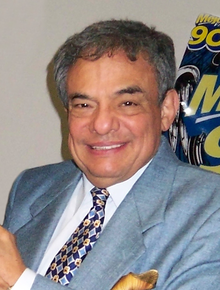
In June 1985, Billboard magazine established Latin Pop Albums, a chart that ranks the best-selling Latin pop albums in the United States. The chart was published on a fortnightly basis with its positions being compiled by sales data from Latin music retailers and distributors.[1][2] According to Billboard, Latin pop includes "the music known as the balada romántica or música interacional" as well as "young pop sounds" and "the new Spanish-language rock".[3] Latin pop emerged as the most commercially successful genre of Latin music throughout the 1980s and 1990s in the US,[4] and the popularity of the balada was propelled by artists such as Julio Iglesias, Camilo Sesto, and Gloria Estefan (lead singer of the Miami Sound Machine at the time).[5] During the 1980s, 22 albums topped the chart.
The first album to reach number one on the Latin Pop Album chart was Reflexiones (1984) by José José.[1] José José was also the artist with the most number-one albums of the 1980s with Promesas (1985), Siempre Contigo (1986), and Soy Así (1987).[6] The three records were the best-selling Latin pop albums of 1986–88, respectively.[7][8][9] Promesas was the longest-running number one with 17 weeks.[6] The Miami Sound Machine was the only band to reach number one in the 1980s with their album Primitive Love (1985). Primitive Love spawned the crossover single, "Conga",[10] which peaked at number ten on the Billboard Hot 100 chart.[11]
Iglesias and Emmanuel were the only other artists to have more than two chart-toppers. Iglesias, who has been recognized as the best-selling male Latin artist of all-time by the Guinness World Records,[12] spent a total of 29 weeks at the apex of the chart with his albums Libra (1985), Un Hombre Solo (1987), and Raíces (1989).[13] Five female acts reached number one on the chart during the 1980s: Ángela Carrasco, Ana Gabriel, Rocío Jurado, Yolandita Monge, and Isabel Pantoja. Pantoja had the best-selling Latin pop album of 1989 with Desde Andalucía (1988) and won the Lo Nuestro Award for Pop Album of the Year in the same year.[14][15] Gabriel culminated the decade with Tierra de Nadie (1988). Recognized as her breakthrough album, it won the Pop Album of the Year award at the following Lo Nuestro Awards.[15][16]
- ^ a b Trust, Gary (March 19, 2010). "Ask Billboard: Battle Of The Rock Bands, Part 2". Billboard. Archived from the original on September 3, 2014. Retrieved June 17, 2010.
- ^ "Billboard's Latin Charts Switch to SoundScan". Billboard. July 10, 1993. pp. 4, 71. Archived from the original on April 1, 2024. Retrieved January 19, 2013 – via Google Books.
- ^ "Debut for New Latin Charts". Billboard. Vol. 97, no. 26. June 29, 1985. p. 3. ISSN 0006-2510. Archived from the original on November 4, 2020. Retrieved December 23, 2020 – via Google Books.
- ^ Knights, Vanessa (April 29, 2016). Music, National Identity and the Politics of Location: Between the Global and the Local. Routledge. p. 211. ISBN 978-1-317-09160-8. Archived from the original on April 29, 2024. Retrieved April 21, 2024 – via Google Books.
- ^ Torres, George (March 27, 2013). Encyclopedia of Latin American Popular Music. Bloomsbury Publishing USA. ISBN 979-8-216-10919-8. Archived from the original on April 29, 2024. Retrieved April 21, 2024 – via Google Books.
- ^ a b "José José - Chart history: Latin Pop Albums". Billboard. Archived from the original on April 2, 2024. Retrieved April 2, 2024.
- ^ Cite error: The named reference
yearend86was invoked but never defined (see the help page). - ^ Cite error: The named reference
yearend87was invoked but never defined (see the help page). - ^ Cite error: The named reference
yearend88was invoked but never defined (see the help page). - ^ Birchmeier, Jason. "Primitive Love — Miami Sound Machine". AllMusic. Archived from the original on December 23, 2023. Retrieved April 1, 2024.
- ^ "Gloria Estefan – Chart history: Hot 100". Billboard. Archived from the original on October 10, 2018. Retrieved April 1, 2024.
- ^ "Julio Iglesias en record Guiness" (in Spanish). Telemundo. April 2, 2013. Archived from the original on April 29, 2024. Retrieved April 1, 2024.
- ^ "Julio Iglesias - Chart history: Latin Pop Albums". Billboard. Archived from the original on March 27, 2023. Retrieved April 2, 2024.
- ^ Cite error: The named reference
yearend89was invoked but never defined (see the help page). - ^ a b "Lo Nuestro – Historia" (in Spanish). Univision. Archived from the original on June 26, 2015. Retrieved March 8, 2014.
- ^ Felci, Michael (July 29, 2005). "Hot Picks". The Desert Sun. p. W3. ProQuest 439713063. Archived from the original on April 29, 2024. Retrieved April 21, 2024.
A stage veteran since age 6, Gabriel burst onto the Tijuana music scene in 1977 with a spirited recording of 'Comprendeme' before breaking through for good with her 1988 album, 'Tierra De Nadie,' which included the smash hit, 'Simplemente Amigos.'